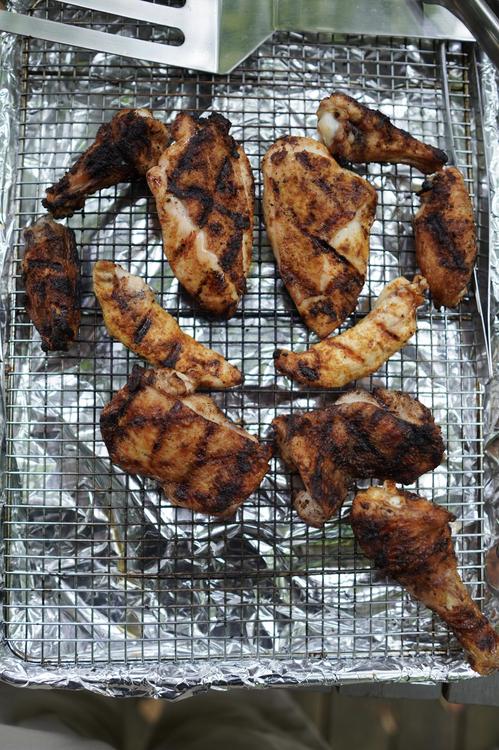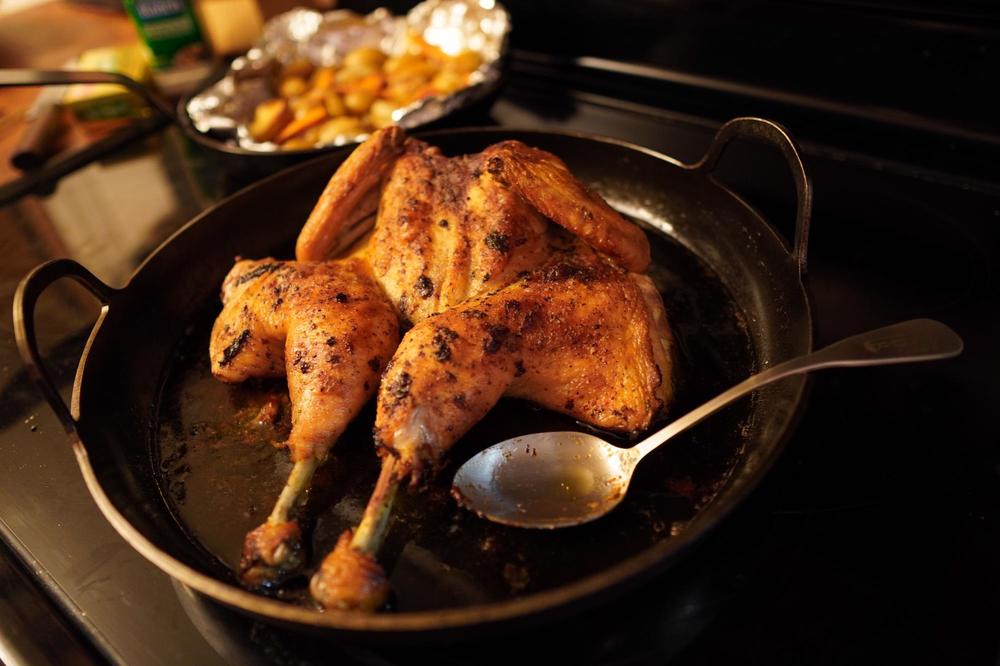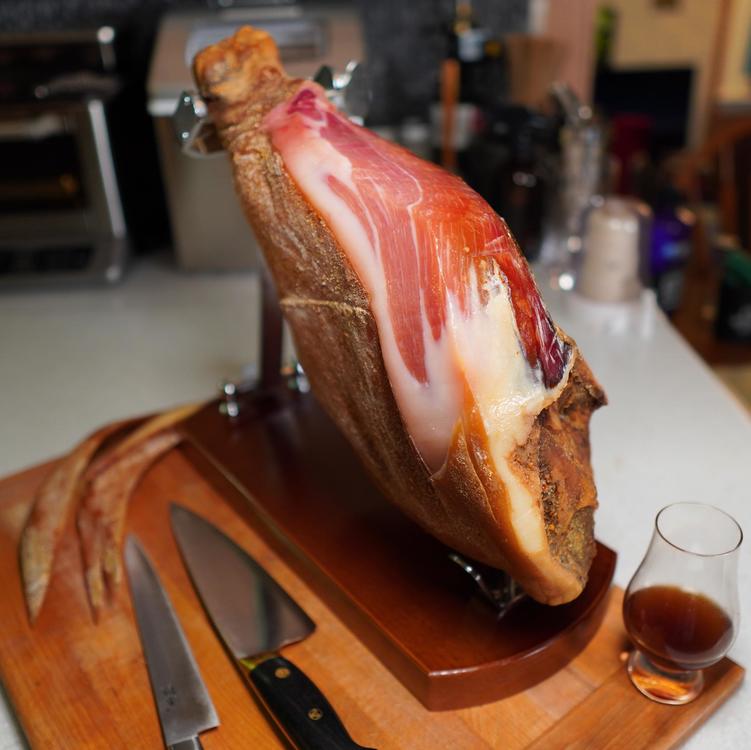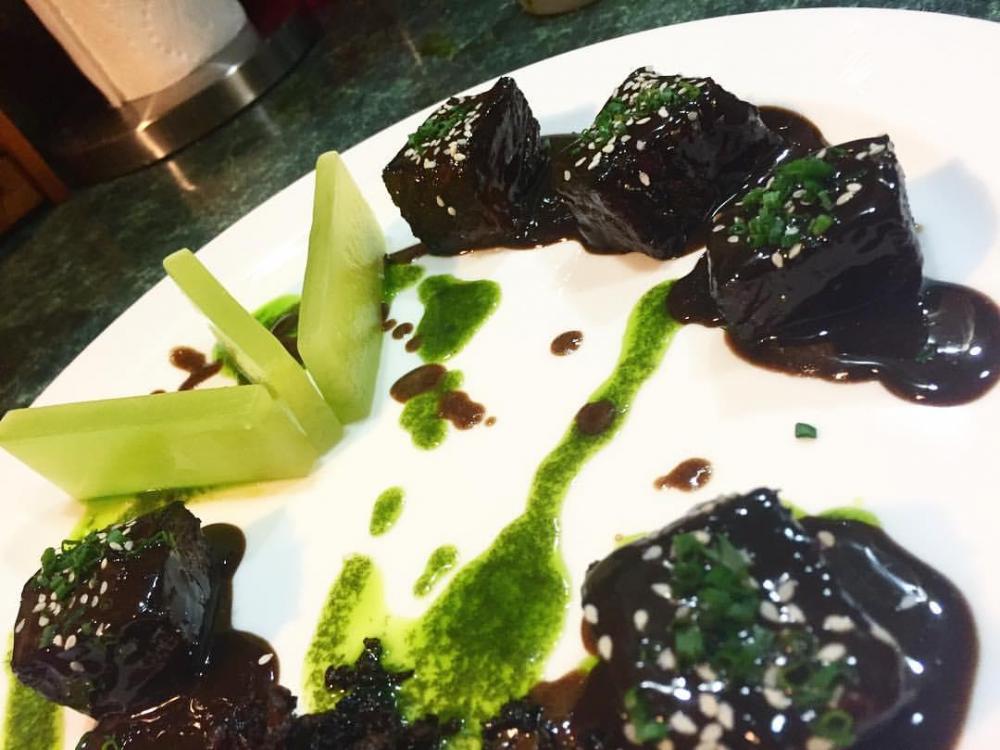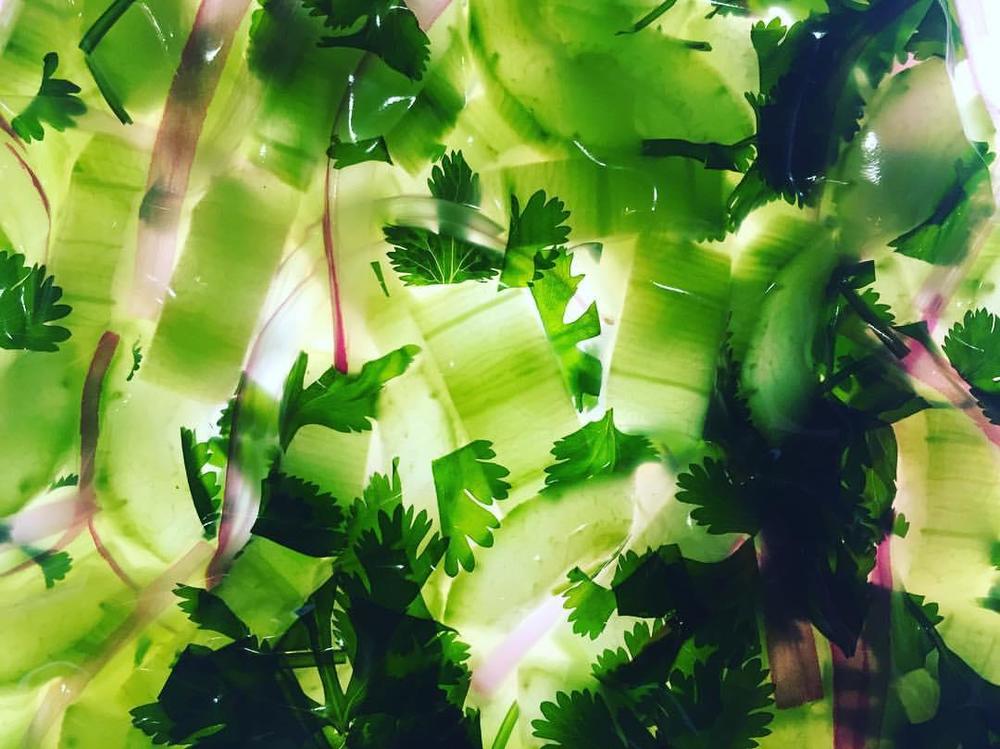-
Posts
1,807 -
Joined
-
Last visited
Content Type
Profiles
Forums
Store
Help Articles
Everything posted by btbyrd
-
Had another poulet rouge in the fridge and decided to cut it up and get grilling. One leg was lost to the tare-making cause, as was the rest of the carcass. This weekend is yakitori time.
-
It's on the back of the packaging, but you have to zoom in on the image on their product to read it.
-
Modernist Pantry sells a powdered glucose with a DE of 95+. I don't know if that's what you're looking for though. Modernist Pantry also sells N -Zorbit in retail quantities, if that's the type of maltodextrin you're looking for.
-
Not that I know of, but if I was trying to track down heritage meats in NYC, I'd get in touch with Heritage Foods USA. They have a mail-order business, but a brick-and-mortar storefront in the city. The founder got his start selling heritage turkeys, and though chicken isn't their primary business I'm sure that if you called and expressed an interest in finding high quality, humanely raised heritage chickens they'd be able to help you out. Heritage Foods runs a non-profit radio network dedicated to food education, and they're an organization I like to support in whatever ways I can. If Heritage Meats is out of chicken, I bet they'd be able to direct you to a quality purveyor. It probably won't be poulet rouge, but you probably won't be disappointed. And you'll probably end up making me jealous of whatever you're able to source there in the city. 😊 Bell & Evans is my default chicken as well. But in the event that there's a special occasion.... Finding these birds offered regularly for sale at my local Whole Foods was about the only wonderful surprise I've had in my supermarket grocery-buying experience in North Carolina. Apologies if I'm crowing a bit too much about this product, but it's a good one. It's rare for us to eat chicken that's over a month old in this country, and that's a shame for everyone (including the chickens).
-
In Chicago there's a fraternal organization of beer and meat called "Man-B-Que." Being a fan of meat, beer, and Tocqueville's view of American civil society, I joined the organization with much enthusiasm. Unfortunately, I lived an hour outside the city when I lived there, and now live 13 hours from the city. So my time there was brief and fleeting, but I think my ManBQue piece on MSG was pretty good. I took some photos of my own glutamate stores, but they didn't survive the migration to the new website. The formatting is now also a disaster. Oh well... that's creative destruction for you, I guess. Anyway, here's a link: MSG: Meaty Savory Goodness I'll leave it for others to decide if there were any choice quotes. I provide a lot of references, which are sorely lacking in what passes for most "science journalism" these days. I use less MSG now than I used to, as I have many more non-synthetic sources of free glutamic acid in my pantry now. I still add a dash of Accent to my stir fry. It's so necessary!
-
Chicken flavor is down to genetics, feed, and lifestyle. Most chicken at the grocery store fails in one or more of these categories. Bell and Evans make a quality air-chilled product, but achieving excellent flavor is not their goal. They still use fast-growing birds slaughtered early before they could live a bird-life, walking around and foraging on land. Living a bird life that's longer than 6 weeks or so is crucial to developing good chicken flavor. In America, we grow breeds that were selected to pack on white meat as fast as possible so the birds can be killed as early as possible. These are the "chickens of tomorrow," and they're why Americans think chicken doesn't taste like anything. The best chicken I can find in my local grocery are the poulet rouge birds on offer from Joyce Farms. To get anything "better," I have to go to the farmer's market. Which I do, sometimes. It isn't often that I get to crow about industrialized animal agriculture, but I am happy to have Joyce Farms in my community bringing quality product to demanding consumers and chefs at a scale most small farmers cannot hope to deliver. They're a North Carolina brand I am proud to represent in my kitchen, and I know many local chefs who are just as proud to represent them on their menus. And apparently their product is in demand in New York City, which pleases me greatly. Here's an overview of their program: And here's a closer look at a particular farm who is producing in the Joyce Farms program. This farm is just under an hour drive from my house, not that I've been there myself. I don't know if this chicken is the best, but it's certainly the best thing I've ever been fortunate enough to find in a grocery store. Bell and Evans and Smart Chicken (or anything else air-chilled, frankly) are a step down, but an acceptable substitute. And sometimes, I admit, I buy the freakshow modern chicken because I am weak willed and/or weak budgeted. It's hard to feed a huge crowd on heritage birds, but maybe that's how it should be.
-
Made a dream come true this Mother’s Day with Benton’s finest. Admittedly, it was my dream... but the crowd seemed to like it too. Carving the ham Spanish style, because why not?
- 235 replies
-
- 10
-

-

-
I don't think Don Quixote would care much about how his food processor looked. If my Cuisinart ever dies, which it probably won't, I'm investing in a commercial Robot Coupe. I care more about the look of my product than the look of the capital, ya dig? But I understand the desire to make your kitchen look good. Maybe keep it in a cabinet, if you can?
-
I like cucumbers vacuum-infused with lime juice. If you want to turn it into a full "dish" you can just marinade cucumbers and thinly sliced red onion in lime juice with some sugar and a dash of fish sauce. Throw in some mixed herbs like cilantro or mint or thai basil or whatever at the end. You can do that with or without a chamber vacuum, but it sure looks prettier if you compress it. Cucumber and short ribs. There was a lime-zest and herb infused macadameia nut oil on the plate too. Citrus oils aren't acidic, but their aromatic qualities can help balance a dish. Also the Modernist Cuisine oxtail demi that has asian infusions. There's a lot of tamarind paste in the glaze to brighten up what is a quite thick and protein-rich glaze. That sauce is freaking magic, but it's a lot of work. If you make it in double quantity, you can freeze what you don't use. And here's a vacuum infused cucumber, red onion, and cilantro salad with that dressing I was talking about. Sometimes I use honey instead of sugar. And I usually use a less refined sugar if I don't have Thai rock on hand. That stuff can be hard to dissolve if you don't bang it out in a mortar first, and who has the time for all that?! Good god compressed cucumber is beautiful. Anyway, with wagyu you need to punch people in the face: Wasabi. Horseradish. Mustard. Acid. Fermented vegetables. In a 4-5oz portion, there is a lot of fat, especially if it's one of the higher grades. Give people big piles of different salts on their plate, and grind some fresh cracked pepper on the side for them. Allow them to season as they go (but season the meat when you cook it, obviously...). Let people be their own Salt Bae. And Pepper Bae. Some boutique soy sauces would be good too. I have a few on hand that would be bangers, including a smoked soy sauce I got from Toiro kitchen. I might also try curing the wagyu between kombu and/or using seaweed salt in your prep work. I have some Japanese ayu fish sauce that's amazing and very hammy -- one of Dave Arnold's favorites. It would probably be even better than Red Boat. Speaking of, Blis makes a barrel aged Red Boat fish sauce that would be great for dipping. Make some nuoc cham, in whatever form or fashion you want. The point is, there are options.
-
I treat everything like it's sushi, but I realize that I'm a bit of a spoiled weirdo in that regard. Honesuki for breaking down chicken; garasuki for turkey legs, hankotsu for deboning (also garasuki!), sujihiki for slicing raw and cooked protein, yanagiba for slicing raw fish. Raw fish slicing is a place where technique is very important, as the flesh is delicate and your technique can elevate or destroy fish flesh. The same thing is true of slicing meat, but "doing it wrong" is usually much less obvious. Unless you do something like cut flank steak or tri tip (or something similar) with the grain and make a potentially tender cut stringy and chewy. Understanding the anatomy of the meat you're cutting can be very helpful in some instances. I've posted this video elsewhere on eGullet, but it shows the inherent difficulty carving a tri-tip roast across the grain for maximum tenderness. "Correct cutting motion" is less important when cutting a tri-tip than knowing where to make your cuts. A lot of good technique is in knowing where and why to cut, not just how.
-
You're trying to reason your way into something that is a practice and a craft. Just go out and cut things and decide for yourself what works and what doesn't work with whatever knives you have on hand. There is no correct answer to the question you're trying to ask. I would cut the same piece of meat differently depending on the knife and the purpose. If you're not sure what to do, experiment. Or if there's a specific piece of meat you're interested in cutting, look on YouTube.
-
Man, I really want that error #27. I think I might do it just for laughs, but I think I'd get cross looks from my dear sweet wife. I've been waiting on a #31 forever, and it seems like they're doing a #30. But they told me last year that the #31 was coming this year... and I couldn't wait. I ended up with a 12" All Clad D7. It is the freaking truth. I love it as much as my Dartos, and the fact that I can do acid in it without worry is a boon. It's thick as nards and weighs 1965g. Only 4.5 pounds, but because it's D7 the evenness and heat-up time are unrivaled [relative to cast iron and reactive steel]. I got a new open box one direct from the factory for roughly Darto prices. I season mine with Bar Keeper's Friend because I like to ride eternal, shiny and chrome.
-
Clay pot cooking is fun and worth a shot if you come across a nice piece that you'd actually use. Things will taste different, but primarily for physical reasons having to do with heat and the nature of the clay than any sort of "terroir" effect of cooking in earthenware. But much clay cookware is porous and can retain odors -- a problem compounded by the fact that you can't put it in the dishwasher. I have 3 lovely donabes that I care for diligently, one of which is used almost exclusively for cooking short grained new crop rice. That rice donabe has a slight ricey fragrance to it at all times. Sometimes I de-aromatize by boiling some water with vinegar added, but that only gets you so far.
-
I started a thread on ChefSteps' forum telling them that they need to make a proper consumer countertop combi oven and sell it around this price point. I even did some due diligence for them and told them what to improve (mostly JUST MAKE IT BIGGER THAN THE CSO!). Cuisinart aren't going to do it, apparently. I bet that there's some stupid reason lurking behind Cuisinart's refusal, like the fact that making it take a quarter sheet pan would interfere with the ability to stack maximal units on pallets in shipping containers. At any rate, consumers want it. This Sharp thing isn't it. Too small. ChefSteps should make it. If they could look at the circulator and imagine Joule, I'm sure they should shrink a Rational combi down to size. Give it a temperature probe, even. Optional wood smoke mode? I dunno... just dreaming.
-
Deep frying in ghee is heavenly. And it is a very stable oil that can be reused. It also has a healthful lipid profile, if the cows were fed on pasture). Expensive, of course, but worth it for a special occasion. If you are going to reuse fry oil, you've got to filter it somehow. Some dedicated fryers have a system that makes this easy, but I typically fry in cast iron on induction so I have no fancy built-in strainers on hand. So I'll filter it through a chinois or a tea strainer depending on the quantity. But Kenji has outlined a fun and creative way to clarify fry oil using gelatin. It's not vegan, of course... but it could be worth trying if you need to get those extra tiny bits of potato starch out of your beef tallow. To get back to disposal issues, I usually pour my cooled fry oil into a ziptop bag and dispose of that with the other household waste. This is easiest with unsaturated fats, because they're liquid and you can just pour them out. Some find this method too messy or fussy, and the Japanese have a solution for them. There is a product called Katameru Tempuru which works to solidify used fry oil so that it's easier to dispose of. I cannot comment on the stuff myself, as pouring it into bags works fine for me. But there are several "cooking oil solidifiers" on the market, if you're in the market for such a thing. Some are even made by S.C. Johnson -- a family company.
-
We've made it. We also got almost "one of everything" to go at Milk Bar Vegas as dessert after our meal at Momofuku. I think we also got crack pie soft serve, but it might have just been two servings of cereal milk soft serve. At any rate... It's a sugar pie. It tastes like a sugar pie. It's good. I was actually pleasantly surprised with how balanced it was, since Christina has a reputation for being a sugar freak and I have reputation for never ordering dessert. My favorite dessert is a proper cheese course with a glass of port. And if not that, then a fruit pie with some cheese and maybe some iced cream. And if not that, then an acid-forward berry sorbet. I'm not the kind of person who wants to mow down on a sugar and flour and corn anything. But I'm a fan of Tosi and a fan of the Momo crew. When in Rome... I don't think "Milk Bar Pie" is a very good name for the product, for multiple reasons. And I cannot imagine taking offense to "Crack Pie," even tough anyone with a brain can acknowledge how horrifically destructive that drug has been (and especially so in the African American community, in part because of garbage and prejudicial sentencing laws that treat crack differently from powdered cocaine). Crack Pie is okay in my book. Just okay. It's nothing to write home about. I don't think I'd make it again, or order it again. And maybe I'd try to come up with a different name, but maybe not. But I'm not a sugar head, even if I did once order (basically) one of everything at Milk Bar Vegas on our way back home from the Grand Canyon. Needs acid. But then again, I acid adjust my juice. So....
-
This isn't really disposal related... but I just wanted to encourage people to get frying.
-

The Food Safety and Home Kitchen Hygiene/Sanitation Topic
btbyrd replied to a topic in Kitchen Consumer
No joke! This is a rule I also follow. People should have a thermometer in their oven, but they should also have two in their fridge -- one on the top and one on the bottom shelf. And you should organize it so that perishable foods that can contaminate things (like raw meat) are physically lower in your fridge so that they only "contaminate downwards." It's the "trickle down" theory of fridge safety. Anyway, double check that your fridge is actually cold where you plan to store your food, and keep it as cold as you can without things freezing. -

The Food Safety and Home Kitchen Hygiene/Sanitation Topic
btbyrd replied to a topic in Kitchen Consumer
My immune system is a beast, so I usually just use the "sniff test." I'm very sensitive to off-flavors in poultry, so microbial safety is usually less of a practical issue for me than palatability. So if you're feeling frisky, I'd say give it a sniff and roll with it. But caveat eater. I probably wouldn't serve it to my grandmother or kid sister. -
It may be bunk, but the fry oil people have thought to add it in. I'm sure your scientific chops are better than my own. The use of silicones in fry oil might be a bunch of stupid industry nonsense (like vacuum marination of meat) but there's at least a purported rationale at work. I look forward to hearing what you're able to find out. I did a quick glance through what I have available to me, and found a couple things that may be interesting on the topic. Here's a relevant literature review and critical discussion from 2004: Effectiveness of dimethylpolysiloxane during deep frying Author: Márquez-Ruiz, Gloria Journal: European journal of lipid science and technology ISSN: 1438-7697 Date: 11/01/2004 Volume: 106 Issue: 11 Page: 752-758 DOI: 10.1002/ejlt.200400999 And another one purporting to establish the utility of DMPS in continuous frying operations. Polydimethylsiloxane Shows Strong Protective Effects in Continuous Deep-Frying Operations Author: Totani, Nagao Journal: Journal of oleo science ISSN: 1345-8957 Date: 2018 Volume: 67 Issue: 11 Page: 1389-1395 DOI: 10.5650/jos.ess18047 Maybe it's all a ruse by Big Silicone. Or maybe the food science guys just don't understand the mechanism properly. In any event, they're adding silicone to commercial fry oil in minute quantities in an effort to stave off oxidation.
-
Meh?
-
Okay... some nuggets from Shirley. Cookwise is an AWESOME book, and her section on frying is fantastic. "New crops like high oleic sunflower oil and low linolenic soybean oil maximize single double bonds and minmize double and triple double bonds, making for more stable and healthful oils. The more healthful unsaturated fats can be used if the oil is not going to be re-used. Considerations like flavor and smoke point may be more important than saturation." (158) That's basically why I keep HO sunflower oil and tallow on hand. Tallow is super stable (and not terrible for you, if your cow didn't spend the last two months of its life in a concentration camp). But for a vegetable-based option, HO sunflower oil is pretty dang good. She does not recommend re-using fry-oil from home because it does not contain the common additives (like anti-oxidants) that help keep commercial fryer oil from breaking down. I don't fry that hot and I use relatively stable fats, so I don't know that this nugget applies across the board. You can always add some mixed tocopherols to your oil if you want to, and create your own "commercial" fry oil. Commercial fry oils contain trace amounts of certain silicones, which form a film on the surface of the oil, preventing direct contact with oxygen in the air (and thereby limiting oxidative rancidity). Solid vegetable shortenings often contain emulsifiers like mono and diglycerides, which makes them good fats to use in cakes but lowers their smoke point and makes them bad for higher temp frying. I couldn't find anything on polarity and browning, but KennethT is right on the money that you don't need to add much "old" oil to fresh oil to reap the benefits of slightly damaged fry fats. The key is that the damage is *slight*. You don't want to slop back a bunch of burned up fishy-smelling rancid garbage oil into your jug. That's not going to be good for anyone.
-
There's some surface activity stuff going on there too, for sure. I'll go reread Shirley Corriher, as it's been a while. She doesn't get nearly enough play! I don't know who McGee's agent is... but maybe she should switch over. 🙂
-
It was on one of the back episodes of Cooking Issues. But the issue of polarity impacting the consistency of fried foods is well documented at the commercial level. Here's an article on monitoring polar compounds in fryer oil. A relevant nugget: "Total Polar Compounds affect the consistency of deep frying by increasing the release of water and the absorption of fats into the product. French fries, for instance, will brown but will be hollow because the moisture has been released too quickly."


